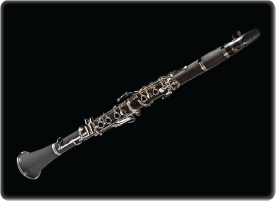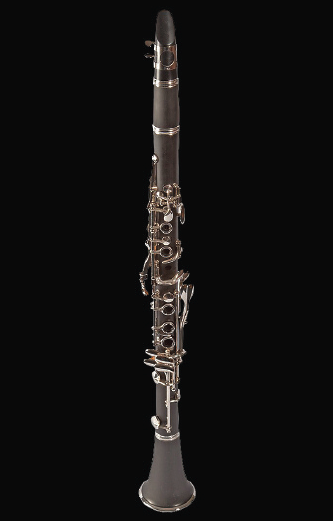RentalInstrument.com offers high quality clarinets for rent or purchase at low prices. Our clarinets are brand new and produce tonal qualities that rival high-end instruments costing much more. At RentalInstrument.com, rent a brand new clarinet for three years and it’s yours to keep for life. Recommended by professional clarinetists and approved by educators and band directors.
I highly recommend the RentalInstrument.com clarinet. The key layout is ideal for beginners and intermediate players. It’s easy to play and offers a nice even tone. I especially like the exterior of this clarinet. The brushed ABS material makes it look like a traditional wooden clarinet but at the same time, it’s durable and long lasting.
About the Clarinet
Invented by Christopher Denner in the 18th century in Germany, the clarinet is a member of the woodwind family. Using a single reed, the clarinet is the largest woodwind instrument that comes in several different types, including the soprano clarinet, basset clarinet, alto clarinet, and bass clarinet.
The clarinet gets its tone from the timbre and cylindrical bore which has three main registers: the chalmeau, clarion, and atissimo. Depending on the musician, the instrument, the reed, the mouthpiece, and the music, the quality of the clarinet’s tone can vary. Of the woodwind family, clarinets have the biggest pitch range.
 Clarinets can be made from a number of materials, including plastic, wood, metal and ivory. Most clarinets used by professional musicians are made from mpingo or African Blackwood. Inexpensive clarinets are usually made from plastic or resin. The mouthpiece is usually made from rubber or plastic. The clarinet also uses pads to cover the tones.
Clarinets can be made from a number of materials, including plastic, wood, metal and ivory. Most clarinets used by professional musicians are made from mpingo or African Blackwood. Inexpensive clarinets are usually made from plastic or resin. The mouthpiece is usually made from rubber or plastic. The clarinet also uses pads to cover the tones.
Russian born clarinetist Iwan Müller developed a type of pad in 1812 that was covered in leather. This proved to be more useful then the original pads which were made of felt. The leather made it so the keys would become completely air tight, and lead to the invention of more keys being added onto the clarinet. Müller’s clarinet included thirteen keys and seven finger holes.
Clarinets use one single reed made from a type of grass, although many synthetic materials are commonly used to make reeds as well. Fastened to the mouthpiece is the ligature. Blowing air through the opening between the mouthpiece and reed causes vibrations in the reed which then produces the clarinet’s sound.
Classical music requires much clarinet participation. The clarinet section in orchestras continued to grow during the end of the 19th century, using up to three clarinetists in a performance. Olivier Messiaen, Gustav Mahler, and Richard Strauss were all composers who in the 20th century, chose to have up to nine clarinetists in the section, including sopranos, basset, alto and bass clarinets.
If you’re looking to play a solo instrument, the clarinet is a great choice. In order to showcase this noble instrument, countless concertos have been written over the clarinet’s history, including a concerti by Weber, Copland, and Mozart, along with many chamber music works.
Wind bands depend heavily on the clarinet, as it plays the central part of the performances, often playing the same notes in the bands as the strings do in orchestras. Other than partaking in general bands and orchestras, the clarinet plays a major role in Dixieland music. Today, Filmmaker and clarinet enthusiast Woody Allen performs often with his quartet in New York, playing New Orleans Jazz-style pieces. The Beatles also used the clarinet in several of their songs, including :”When I’m Sixty-Four” as does alternative rock band Radiohead in their song “Life in a Glasshouse”.
Clarinet Care Tips
The following care tips will ensure that your clarinet stays in excellent condition.
- The clarinet should be properly cleaned after playing and before being put back into its case. You want to remove the saliva and warm air that accumulated inside the clarinet when it is being used. This also insures that the clarinet will retain its shine.
- Always remove the reed after playing. Store it in a reed case so it can dry!
- Wipe fingerprints off the ligature and keys with a polishing cloth. Using any kind of metal polish is unnecessary. Only use key oil on your keys so insure the keys will move easily.
- Remove the mouthpiece. Using your swab, the cloth’s weight drops and gets strung through the clarinet from the barrel to the bell. Pull it through. This can be repeated several times. Dry the tenons after the pieces have been pulled apart. Before returning the swab to the case, let it dry.
- Use your cork grease. Rub the cork grease on the corks using your fingers. Do not grease the corks too often, however, as this will cause the corks to weaken and fall apart. Apply as needed depending on the corks’ dryness or wear.
- Polish the keys using your cleaning cloth to remove grime and fingerprints. A dusting stick can also be used. This is a long, thin wire with a small broom on one end and what resembles a tooth-cleaner on the opposite end. Take out your cleaning cloth and polish the keys to remove fingerprints and grime. Carefully clean under and between the keys with the tooth-cleaning look-a-like end and use the broom end to dust off. Look for grime on the tone holes that your fingers cover.
- It’s also always a good idea to clean the insides of the clarinet’s joints using the swab to get rid of the excess saliva there, with or without the cork.
- Put the cap over the mouthpiece and store the clarinet in its case whenever it is not being used.

